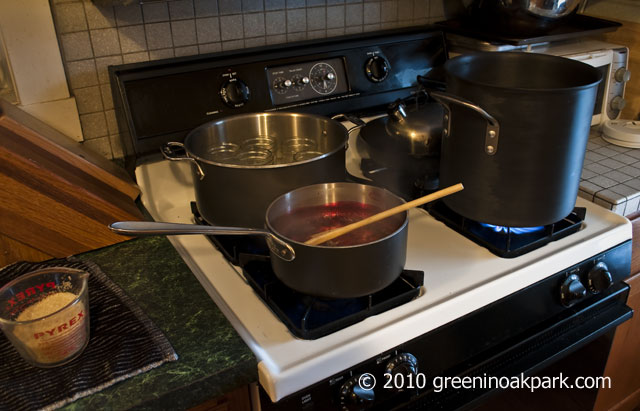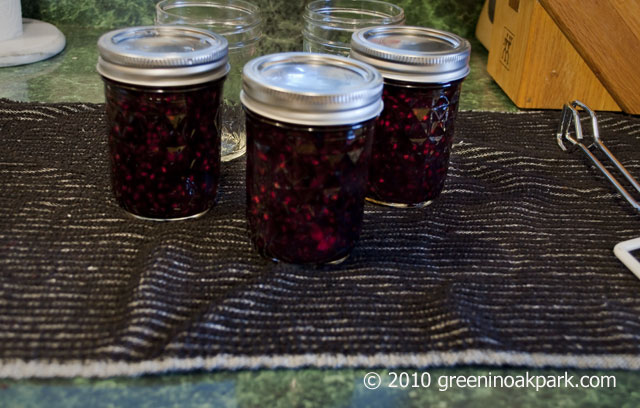Blackberry season is upon us, and the blackberry bush is providing about 2-4 ripe blackberries a day now. It’s not quite enough at one time to make jam, so I bought some from the farmers market this weekend.
Preserving food that is acidic, which includes tomatoes and other fruit, is much easier than preserving other types of food. Instead of the pressure canner that is required for safe canning of vegetables, you can use a water bath canner, which is basically a large stockpot with a tight lid and a rack you can place in the bottom. The jars go in the rack. This way they don’t knock into each other and break, and there’s water under the bottoms of the jars as they process. This is necessary for safe water bath canning so that the food in the bottom is heated to an adequate temperature to kill any microbial nasties. A very tall stockpot with a round cooling rack in the bottom is also fine for this purpose, as long as the jars are covered by 1-2 inches of water as they’re processing, and as long as the lid fits tightly.
The blackberry jam I made is a variation on the recipe in Putting Food By, which I still recommend as a classic on food preservation. They call for equal parts blackberries and sugar, which is fine to do because blackberries are naturally high in pectin already. Other fruits require added pectin. They also recommend boiling your mashed fruit and then putting it through a food mill to get rid of seeds, then re-adding to the pot to continue. I opted not to use the food mill.
Here’s how I did it, and in the proportions I used. You can safely double this recipe, but no more than that because pectin isn’t all that cooperative beyond doubling.
What you’ll need
– 1 very tall stockpot with round rack and tight lid
– 1 pot with an inch or two of water in the bottom
– 1 kettle/pot for boiling the fruit mixture
– 3 (four) 8oz canning jars with new lids and bands, or 6 (six) 4oz jam jars
– canning funnel, available in canning kits
– dish towel spread out on the counter
– jar lifter and canning tongs, available in canning kits
– 2 cups mashed blackberries (I used a potato masher)
– 2 cups sugar
– about 1 tablespoon regular pectin, though you can add more for firmer jam and less for less firm jam, and I’m adding it because I think even a little pectin makes for a better jam
What you’ll do
In the very tall stockpot, place the rack at the bottom and fill with enough water to cover a jar that’s sitting in the rack with 1-2 inches of water. Heat to boiling while you perform other tasks.
In the pot with an inch or so of water in the bottom, place all your jars in the upright position as well as the lids. Heat on medium-high heat. It’s not necessary to boil, but keeping them hot helps prevent breakage when you put your hot jam in them.
In the third pot, add your mashed berries and heat while stirring in your pectin. Keep stirring constantly, then stir in the sugar. Boil at a rapid, hard boil (meaning it can’t be stirred away) for a minute or two.
Ideally you’ll have all three going at once to save time.
After the jam has boiled for a minute or two, skim off the thin layer of foam at the top (which you can save for fresh jam if you like), remove the jars from the hot water with a jar lifter and place them upright on the dish towel. Place your canning funnel into each jar and pour or ladle the jam into the jars, leaving 1/4 of an inch head room on top. The funnel should prevent any jam from getting on the rim, but if it does, you must remove all of it before processing or it won’t seal properly.
Remove the lids from the hot water with the tongs and place them securely on the jars. While holding the jars with an oven mitt or a corner of the dish towel, take a band and screw it tightly on each jar by hand.
Hopefully by now your very large stockpot is almost at a boil. When the water is at a rapid boil, use your jar lifter to lower the jars into the rack. You can lift the rack out, put jars in, and then lower it back in if you’re more comfortable with that method. Cover and turn down the heat enough that the rapid boil continues but doesn’t boil over, and process the jars for 10 minutes. If you’re above sea level, check to see how much longer you should process the jars. Your pectin probably has that information included.
When time is up, use your jar lifter to remove the jars and put them on the dish towel, or pull the rack out and put it on the dish towel and then lift them out with the jar lifter.
Within a few minutes, you should hear a click as the lids seal. They should cool before you open them, and you should test the seal before putting them away. The easiest way to do that is to hold the jar over a pot with a dish towel in the bottom, unscrew the band – although if you have to use lots of force, that might unseal your jars – and then pick up the jar with the edge of the lid. The lid shouldn’t budge and the jar shouldn’t fall. The lid also shouldn’t depress at all if you press it in the middle. If the lid depresses or if the jar can’t be lifted by the lid, then you can re-process, but it’s safest to refrigerate it and eat it right away.
ALL THAT SAID. I really do encourage you to pick up Putting Food By or another reputable canning book, or to take a class or learn in whatever way is best for you. Proper canning technique can mean the difference between botulism and no botulism – and botulism can be deadly serious, if you know what I mean. As this is primarily a recipe and not a tutorial on canning, I have omitted some principles of canning, such as never reusing lids and other safety procedures, but anyone who cans should know them. Although I’m hoping to learn this year, I haven’t even canned with a pressure canner yet, so I am not at all a master canner. I don’t want anyone getting sick out there.
Have fun extending the season, and happy (and safe!) eating!







Pingback: Blueberry Jam | Green In Oak Park